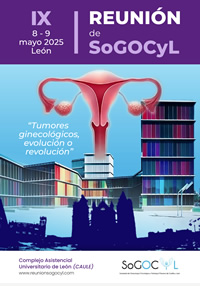



IX Reunión de la Sociedad de Ginecología Oncológica de Castilla y León
Nos complace invitaros a la IX Reunión de la SoGOCyL, que se celebrará en León los días 8 y 9 de mayo de 2025.
VIII Reunión de la Sociedad de Ginecología Oncológica de Castilla y León
Este 2023 nos complace anunciar que la VIII Reunión de la SoGOCyL tendrá lugar los días 16 y 17 de noviembre en Valladolid.
VII Reunión y I Online SoGOCyL 2021
En 2021 la Reunión de la Sociedad de Ginecología Oncológica de Castilla y León se celebrará online los días 2 y 3 de junio.
Jornadas SoGOCyL 2020
La VII Reunión de la Sociedad de Ginecología Oncológica de Castilla y León tendrá lugar los días 7 y 8 de mayo de 2020 en León.
Asamblea Constitutiva de la SoGOCyL, con fecha de 28/1/2011.
En Valladolid, siendo las 17.40 horas del día 28 de enero de 2011, se reúnen la Junta Directiva de la SoGOCyL propuesta y otros ginecólogos de la Comunidad Autónoma de Castilla y León en la sala de Conferencias del Hospital Universitario Río Hortega.
El objeto de la reunión es celebrar la Asamblea Constituyente de la SoGOCyL –Sociedad de Ginecología Oncológica y Patología Mamaria de Castilla y León–. Actúa como Presidente de la Junta Directiva el Dr. Alfonso Fernández Corona y como Secretario con carácter accidental el Dr. Ignacio González Blanco. El vocal Dr. Ángel García Iglesias no acude y presenta previamente su renuncia a la vocalía, por lo que se propone en su sustitución a la Dra. Verónica Sancho de Salas. Entre los asistentes a la Reunión se encuentra además, como representante, asesor y participante activo el Presidente de la SoGICyL –Sociedad Ginecológica de Castilla y León–, Dr. Luis Peñalosa Ruíz.
The Evolving Role of Adjuvant Therapy in Endometrial Cancer
Escrito por SoGOCyL Viernes, 21 de Enero de 2011 23:25The Evolving Role of Adjuvant Therapy in Endometrial Cancer
Crit Rev Oncol Hematol. 2011 May; 78(2):79-91; A Gadducci, C Greco
Abstract
Extra-fascial total hysterectomy and bilateral salpingo-oophorectomy with or without lymph node dissection is the initial treatment for endometrial cancer. Unresolved scientific controversy exists regarding the selection of patients who may benefit from lymphadenectomy, the magnitude of such benefit, and the role of adjuvant therapy. External pelvic irradiation has been shown to reduce loco-regional recurrences without improving survival. Meta-analyses of randomized trials indicate that external pelvic irradiation offers a significant benefit in terms of survival only in high-risk disease (i.e. stage Ic grade 3). Intermediate risk patients (i.e. stage Ib grade 3 disease), therefore, may be treated with adjuvant intravaginal brachytherapy alone to avoid the risk of side effects associated with pelvic irradiation. Overall, patients with clinically early endometrial cancer develop relapses in less than 20% of cases, mostly at distant sites.
Sentinel lymph node biopsy in the management of early-stage cervical carcinoma
Escrito por SoGOCyL Jueves, 20 de Enero de 2011 23:07Sentinel lymph node biopsy in the management of early-stage cervical carcinoma ☆
A prospective no-randomized clinical trial
John P. Diaz (a),1, Mary L. Gemignani (a), Neeta Pandit-Taskar (b), Kay J. Park (c), Melissa P. Murray (c=, Dennis S. Chi (a), Yukio Sonoda (a), Richard R. Barakat (a), Nadeem R. Abu-Rustum (a)
(a) Gynecology Service, Department of Surgery, Memorial Sloan-Kettering Cancer Center, New York, NY, USA, (b) Department of Radiology, Memorial Sloan-Kettering Cancer Center, New York, NY, USA, (c)- Department of Pathology, Memorial Sloan-Kettering Cancer Center, New York, NY, USA
Gynecologic Oncology 120 (2011) 347–352
Keywords: Sentinel lymph nodes, Micrometastasis, Cervical cancer
Objectives. We aimed to determine the sentinel lymph node detection rates, accuracy in predicting the status of lymph node metastasis, and if pathologic ultrastaging improves the detection of micrometastases and isolated tumor cells at the time of primary surgery for cervical cancer.
Methods. A prospective, non-randomized study of women with early-stage (FIGO stage IA1 with lymphovascular space involvement — IIA) cervical carcinoma was conducted from June 2003 to August 2009. All patients underwent an intraoperative intracervical blue dye injection. Patients who underwent a preoperative lymphoscintigraphy received a 99 m Tc sulfur colloid injection in addition. All patients underwent sentinel lymph node (SLN) identification followed by a complete pelvic node and parametrial dissection. SLN were evaluated using our institutional protocol that included pathologic ultrastaging.
Fertility considerations in the management of gynecologic malignancies
Escrito por SoGOCyL Miércoles, 19 de Enero de 2011 23:36Fertility considerations in the management of gynecologic malignancies
Review
Nicole Noyes (a), Jaime M. Knopman (a), Kara Long (b), Jaclyn M. Coletta (c), Nadeem R. Abu-Rustum (b)
(a) Division of Reproductive Endocrinology, New York University School of Medicine, New York, NY, USA. (b) Division of Gynecologic Oncology, Memorial Sloan-Kettering Cancer Center, New York, NY, USA. (c) Division of Maternal Fetal Medicine, Columbia University Medical Center, New York, NY, USA
Keywords: Fertility preservation, Oocyte cryopreservation, Cancer, Parenthood, Quality-of-life
Goals. Gynecologic cancers represent a significant proportion of malignancies affecting women. Historically, cancer treatment focused primarily on eradicating disease, irrespective of the impact on fertility. The implementation of early detection protocols and advanced treatment regimens has resulted in improved prognosis for gynecologic cancer patients. With this improvement, more attention is now paid to quality-oflife issues. Fertility preservation (FP) has become an integral component in the selection and execution of gynecological cancer management. In this report we address gynecologic malignancies as they relate to future fertility potential.
Methods. We review reproductive principles such as ovarian reserve, uterine function, cervical competence, and early obstetrical management, as well as available FP methods. In addition, we discuss the potential damage that cancer and cancer treatments can impart on the female reproductive system. We offer general recommendations regarding baseline screening tests useful in assessing the feasibility of FP. Lastly, cancer-specific FP methods are presented.





